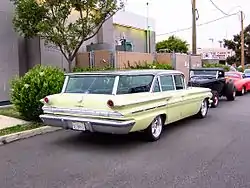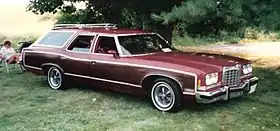Pontiac Safari
The Pontiac Safari is a station wagon that was produced by Pontiac. The Safari name was first applied to Pontiac's version of the 2-door Chevrolet Nomad station wagon. The body style, originally exhibited as a 1954 Chevrolet Corvette Motorama concept car, was shifted to Chevrolet and Pontiac full-size 1955 production vehicles because of the perceived greater sales potential.
| Pontiac Safari | |
|---|---|
 1964 Pontiac Catalina Safari | |
| Overview | |
| Manufacturer | General Motors |
| Production | 1955–1957 1958–1991 (as the wagon trim) 1987–1989 (last Safari model) |
| Layout | FR layout |
During its run, the Safari would be sold as its own station wagon model as well as a designation applied to Pontiac's various other station wagon vehicles. The name "safari" is derived from the Swahili word safari, which means journey, originally from the Arabic سفر (safar) meaning a journey; the verb for "to travel" in Swahili is kusafiri.
1955–1957 Safari
| 1955-1957 | |
|---|---|
 | |
| Overview | |
| Production | 1955–1957 |
| Body and chassis | |
| Body style | 4-door station wagon 2-door station wagon |
| Platform | A-body |
| Dimensions | |
| Length | 204.3"[1] |
1955
The 1955 Safari was built using the Pontiac Chieftain, and shared body components with the Chevrolet Nomad station wagon, which would also allow both divisions to share in the tooling costs for the special bodied wagons. The Safari was fitted with Pontiac's unique front-end bumper/grille assembly and sheet metal and rear tail light design, both created by Pontiac stylist Paul Gillan. Gillan received a United States patent for the bumper/grille design.
The Safari featured sport-coupe front doors, extra chrome adorning the tailgate and interior, and sliding rear-seat windows. Like the Nomad, the "B" pillar of the station wagon was raked forward, a flourish not shared with other GM two-door station wagons from that era.
Interior trim, upholstery and bright work were equal to Pontiac's top line Star Chief range of models, however the Safari was actually the only model in the Star Chief Custom (Series 27). Production of the 1955 Safari stood at a model year production of 3,760, making it the lowest production Pontiac for 1955.
1956

With its unique body style only a year old, Pontiac limited changes to the Safari to match those of the 1956 Star Chief. Again as in 1955, the Safari was the only model in the Star Chief Custom series (27). Sales of the Safari improved slightly for 1956, with 4,042 vehicles produced; still the lowest production Pontiac for 1956.
1957

For 1957, Pontiac applied the Safari nameplate to all of its station wagons in all of its product lines (Chieftain, Super Chief and Star Chief Custom).
While the high-trim unique two-door body style was still available, Pontiac added a four-door high-trim version to the Star Chief Custom series mid-year which was named Safari Transcontinental. This half year series featured special exterior trim to set it apart from other Pontiac station wagons. Despite only being on the market for the last half of the 1957 model year, the Safari Transcontinental outsold the special-bodied two-door Safari 1,894 to 1,292.
At the end of its three-year run, the specially bodied two-door sport wagon sold only 9,094 vehicles compared to the Chevrolet Nomad which sold 20,092 copies in its three-year run.
1958–1991

General Motors discontinued its unique sport wagon body at the end of the 1957 model year, and henceforth, all full-size station wagon models produced by Pontiac would be named for their series, and as Safaris. While a two-door Safari was fielded in 1958 in Pontiac's Chieftain range, it shared its body with Chevrolet's price leader Delray station wagon. Both models came with few features and were popular with tradespeople and small businesses.

Many Pontiac models fielded Safari labeled variants including the Astre, Bonneville, Catalina, Executive, Grand Ville (Grand Safari), LeMans/Grand LeMans, Parisienne, 6000, Sunbird, and Tempest.
For 1966 Pontiac dropped the Safari name on the full sized B-body, Catalina and Bonneville, and named them only as station wagon. For 1967 the Safari name plate returned for the new Executive wagon, which were placed between Catalina and Bonneville in range. Catalina and Bonneville continued to have the station wagon label only.
The Safari name was also used on the 1975-77 Astre 2 door wagon and the 1978-79 Sunbird Sport Safari 2 door wagon which were derived from the GM H-body platform
The last Pontiac to carry the Safari name alone was the late 1980s station wagon version of the full-size Parisienne. After Parisienne sedans were discontinued in 1986, the station wagon continued on for three more model years renamed and sold as simply Safari.
1989 was the last year Safari was sold as its own Pontiac model but not the last year the Safari name was used. The 1991 6000 station wagon, sold as the Pontiac 6000 LE Safari, was Pontiac’s last model to carry a Safari designation. GMC would continue to use the Safari name for its minivan model through 2005.
1971–1978 Grand Safari

The Grand Safari was Pontiac's top-of-the-line full-size station wagon offered from 1971 to 1978. The Grand Safari used the grille and interior trim of the Bonneville and Grand Ville passenger car series, and most (but not all) examples were trimmed with woodgrain paneling on the sides and tailgate.
The 1971 to 1976 models were the largest Pontiacs ever built. The 1971-76 GM full-size bodies, at 64.3" front shoulder room and 63.4" rear shoulder room set a record for interior width that would not be matched by any car until the full-size GM rear-wheel drive models of the early to mid-1990s. The Grand Safari wagons, as did other GM full-sized wagons during these years, used a unique rear suspension with multi-leaf springs instead of the coil springs used on other full-sized Pontiacs, and other full-sized GM cars. The Grand Safari wagons also featured a new 'Clamshell' tailgate design where the rear power-operated glass slid up into the roof as the tailgate (manually or with power assist), slid into a recess under the cargo floor. The power tailgate, the first in station wagon history, ultimately supplanted the manual tailgate, which required marked effort to lift from storage. It was operated by switches on the instrument panel or a key switch on the rear quarter panel. The Clamshell system, heavy and complex, made it easier to load and unload the extremely long wagons in tight spaces. But it remained un-adopted by any other manufacturer, and would be eliminated when GM reduced the length of their wagons by about a foot in 1977, and the overriding concern became increased fuel economy.
The 1971-76 Grand Safaris, shared their 127.0 in (3,226 mm) wheelbase with the Buick and Oldsmobile C-body cars but were designated as B-body models. At 231.3 in (5,875 mm) in length the 1974-76 Grand Safaris are the longest Pontiacs ever built. And at 5,112 lb (2,319 kg) shipping weight, or about 5,300 lb (2,400 kg) curb weight, the three-seat 1974 Grand Safari wagons are easily the heaviest Pontiacs ever built.
These wagons ran with V8 engines of either 400 or 455 cubic inches.
The 1977 Grand Safari was downsized considerably, with wheelbase cut to 115.9 inches, length to less than 18 feet and weight to just over 4,000 pounds. These wagons thus could run with smaller engines, either a standard 301 or optional 403 V8; a 350 V8 was additionally offered on 1978 models. Replacing the Glide-Away Tailgate was a three-way tailgate not unlike that used on Ford station wagons. In 1979, the Grand Safari's name was changed to Bonneville Safari.
Discontinuation of the Safari

In 1989 the Safari model was discontinued due to the decreasing popularity of full-size station wagons. Pontiac was rather late to come to this decision, as Chrysler produced its last full-size station wagon in 1977. Ford discontinued its Country Squire and Mercury Colony Park wagons in 1991. The other GM wagons were the last to go with the Oldsmobile Custom Cruiser being discontinued after the 1992 model year, and finally the Chevrolet Caprice Wagon and the Buick Roadmaster Estate Wagon being discontinued in 1996. The Safari name lived on with the GMC Safari minivan, which largely served the same demographic as the Pontiac Safari. In 1990, the passenger and cargo space of the Safari was replaced largely by the Pontiac Trans Sport, their first minivan.
References
- "Directory Index: Pontiac/1955 Pontiac/1955_Pontiac_Wagons_Brochure". Oldcarbrochures.com. Retrieved 2011-11-20.
- Gunnell, John, Editor (1987). The Standard Catalog of American Cars 1946-1975. Kraus Publications. ISBN 0-87341-096-3.CS1 maint: multiple names: authors list (link)
- 1955-57 Pontiac Safari: An Expedition Into the Unknown, Collectible Automobile Magazine, December 1992, pp. 67–74.
| Wikimedia Commons has media related to Pontiac Safari. |
